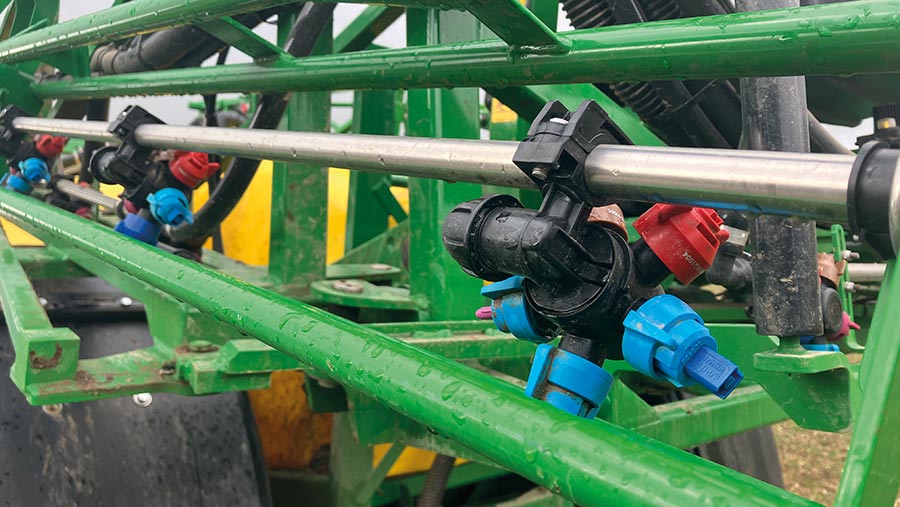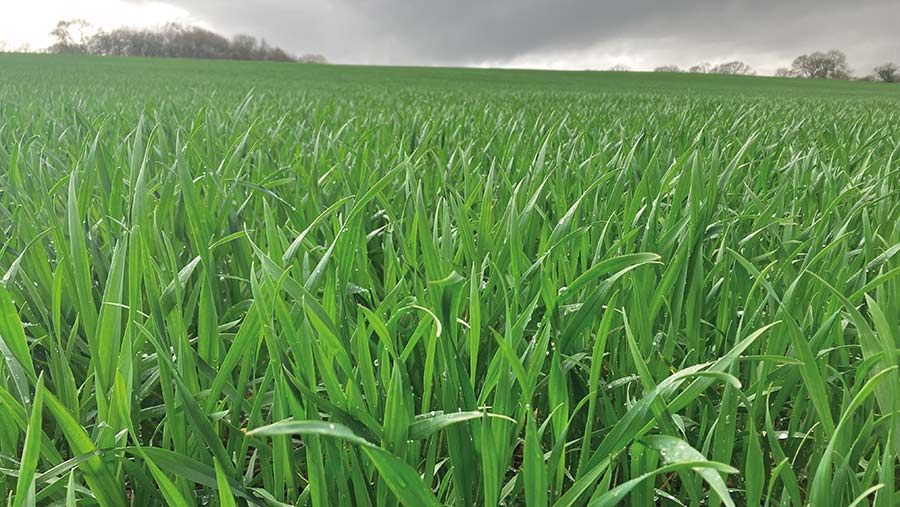Liquid fertiliser wheat trial sees reduced blackgrass and costs
 © MAG/Emma Gillbard
© MAG/Emma Gillbard Jono and Esme Holland trialled a controlled-release liquid fertiliser on feed wheats last season and found that it not only cut costly ammonium nitrate rates, but significantly reduced blackgrass pressure.
The product, MZ28, is a foliar-applied urea fertiliser originally destined for use in maize crops but now approved for cereals and oilseeds.
Its formulation aims to target N to winter wheat crops and reduce blackgrass development.
See also: Online course to help farmers tackle ammonia emissions
After some initial concerns about adding the spray to the wheat programme at Oakhouse Farm, near Hungerford in Berkshire, Mr Holland is pleased with the results and plans to use the product again.
“By trying MZ28 we’ve seen a notable difference to crops. The wheats stayed greener for longer and blackgrass weeds had visually smaller heads.
“A change in mindset has really paid off, and we’re feeling confident about using it across the whole wheat area this season,” he says.

Esme and Jono Holland © MAG/Emma Gillbard
Farm Facts: Oakhouse Farm, Hungerford, Berkshire
- 425ha of combinable crops – winter wheat, spring wheat, winter barley and winter oilseed rape
- Light stony chalk soils
- Establishment: Weaving Sabre Tine no-till drill
- Winter wheat area totals 280ha of Cranium and Dawsum which will all receive a final N spray of MZ28
Blackgrass reduction
The reduction in blackgrass was clear where the slow-release fertiliser was applied, with fields demonstrating smaller weed heads and less seed return.
“The grassweed was notably less vigorous, remaining below the wheat canopy so the crop looked cleaner,” adds Mrs Holland, who is an Agrovista agronomist and looks after the agronomy on the farm.
In feed wheats, the spray replaces 40-50kg/ha N at the final fertiliser split between T1 and T2, following a conventional nutrition programme.
Applying the spray at this timing means the target wheat canopy is larger and blackgrass is not poking its head above.
The wheat crop can, therefore, effectively intercept the fertiliser and block it from the blackgrass.
The grassweed competes for nitrogen considerably greater at soil rather than leaf level, which the foliar feed avoids.
The slow-release fertiliser now forms part of the farm’s blackgrass control strategy.
Together with delaying drilling by a month (now starting in mid-October) and the inclusion of more spring crops such as 160ha of spring wheat, the couple hope this will effectively tackle the grassweed issue.

The product is applied using standard blue flat fan nozzles © MAG/Emma Gillbard
Reducing scorch and disease
The formulation’s low salt content prevents leaf scorch, even when applied at high temperatures. “Our final N split can be vulnerable to scorch as crops are lush and forward.
That’s why the spray’s gentler formulation is a massive bonus for us,” Mr Holland says.
The slow-release mechanism also reduces disease risk as crops are not taking up huge amounts of nitrogen and rapidly developing lush leaves, which can increase fungal pressure.
Mr Holland explains: “Normally within five to eight days of applying conventional foliar fertiliser, we see a boost in crops which develop a lush dark green leaf colour. With the MZ28 this didn’t happen.
At first, I was concerned crops were not getting the nutrition they needed, but in reality they were provided with N over a longer period.”
Despite last summer’s heatwave which caused many crops across the UK to burn off earlier, the Hollands experienced a later harvest than usual.
They put this down to the slower-release N which kept crops greener and growing for longer.

© MAG/Emma Gillbard
How it works
The spray’s oily, resinous quality evenly covers the target leaf, ensuring it remains on the surface for longer with a slower uptake.
Mrs Holland says the formulation consists of a range of specialised polymers which release N over six to eight weeks.
“The different sized polymers break down at various speeds. Shorter-chain polymers are absorbed by the plant faster than longer-chain molecules, to create the slow-release mechanism,” she says.
This provides a sustained source of nitrogen to the crop, especially beneficial during the rapid growth phase and during dry periods. The product is also highly rain-fast.
Nitrogen use efficiency is greater compared with conventional sources, with 85-95% of the N applied used by the plant.
“It’s particularly useful when applying fertiliser in a dry year as it sticks to the leaf surface and minimises risk of volatilisation,” says Mr Holland.
Application rates
Just 35 litres/ha of MZ28 provides the equivalent of 50kg/ha of soil-applied nitrogen, and 28 litres/ha replaces 40kg/ha.
For Mr and Mrs Holland, this meant using MZ28 in place of the final split of their four-way foliar nitrogen spray programme, which totals 220kg/ha N.
Mr Holland says: “I applied three passes of our standard liquid N totalling 165kg/ha and the final 50kg/ha spray was the slow-release fertiliser.
“This was made up to a 100 litres/ha volume with water and applied using standard blue flat fan nozzles at 2.5 bar and speed of 12kph.”
The MZ28 formula is highly tank mixable, but as it was the first time the spray was used on the farm, the couple applied it in a separate pass to avoid any potential complications.
Now they are more confident using the product, they are considering adding it to a tank mix.
For more information on the product, contact Esme Holland at esme.holland@agrovista.co.uk.
Benefits of controlled-release liquid nitrogen fertiliser MZ28
- Potential to reduce blackgrass by targeting N to wheat crops
- Controlled release over 6-8 weeks with sustained nutrient provision
- Enhanced formulation to minimise risk of volatilisation
- Keeps crops greener and growing for longer
- Improved nitrogen use efficiency of up to 85-90%
- No risk of leaf scorch
- Useful soil health benefits – avoids bacterial blooms
- Can be applied during dry weather
- Can help reduce disease levels
- Reduced carbon footprint

